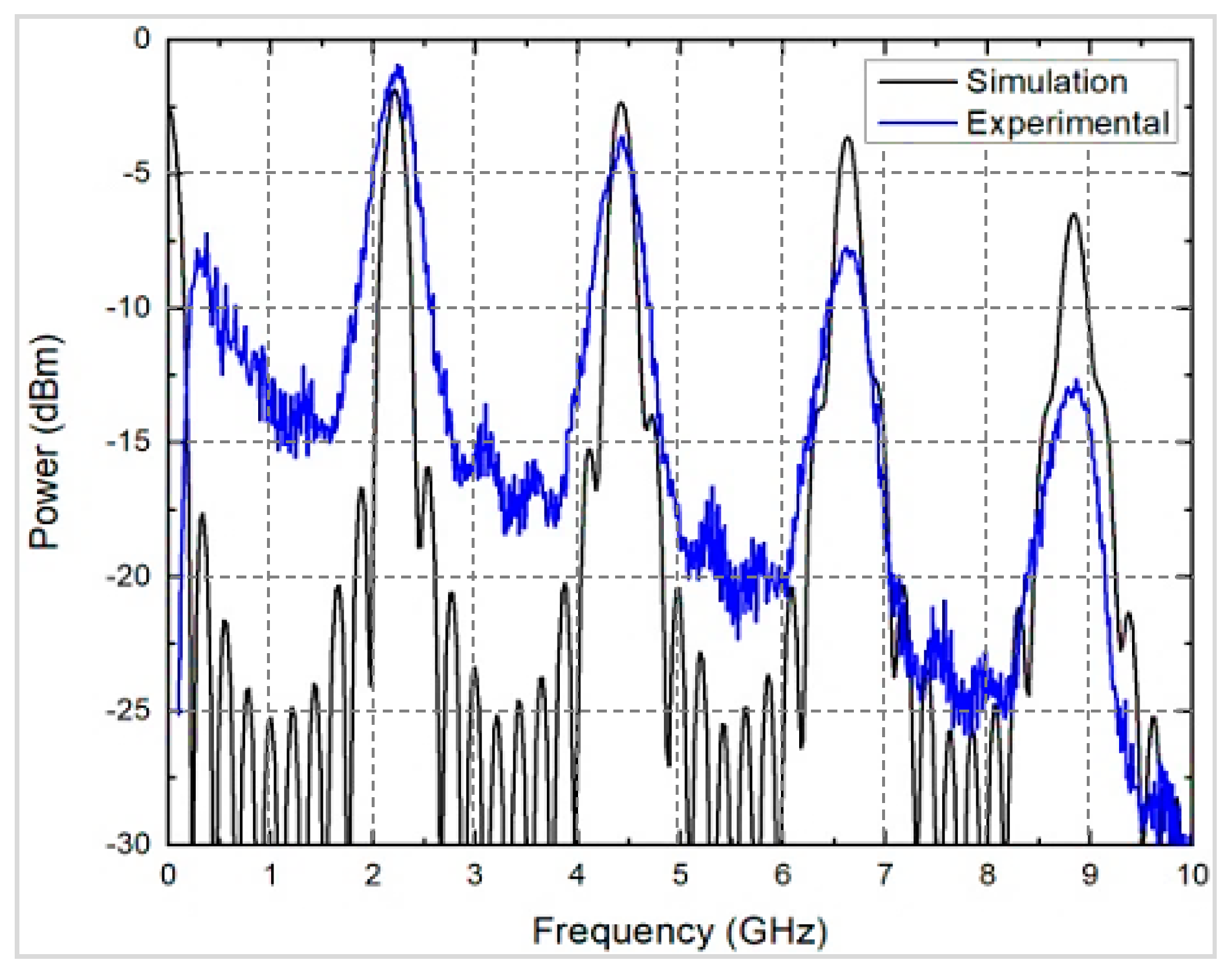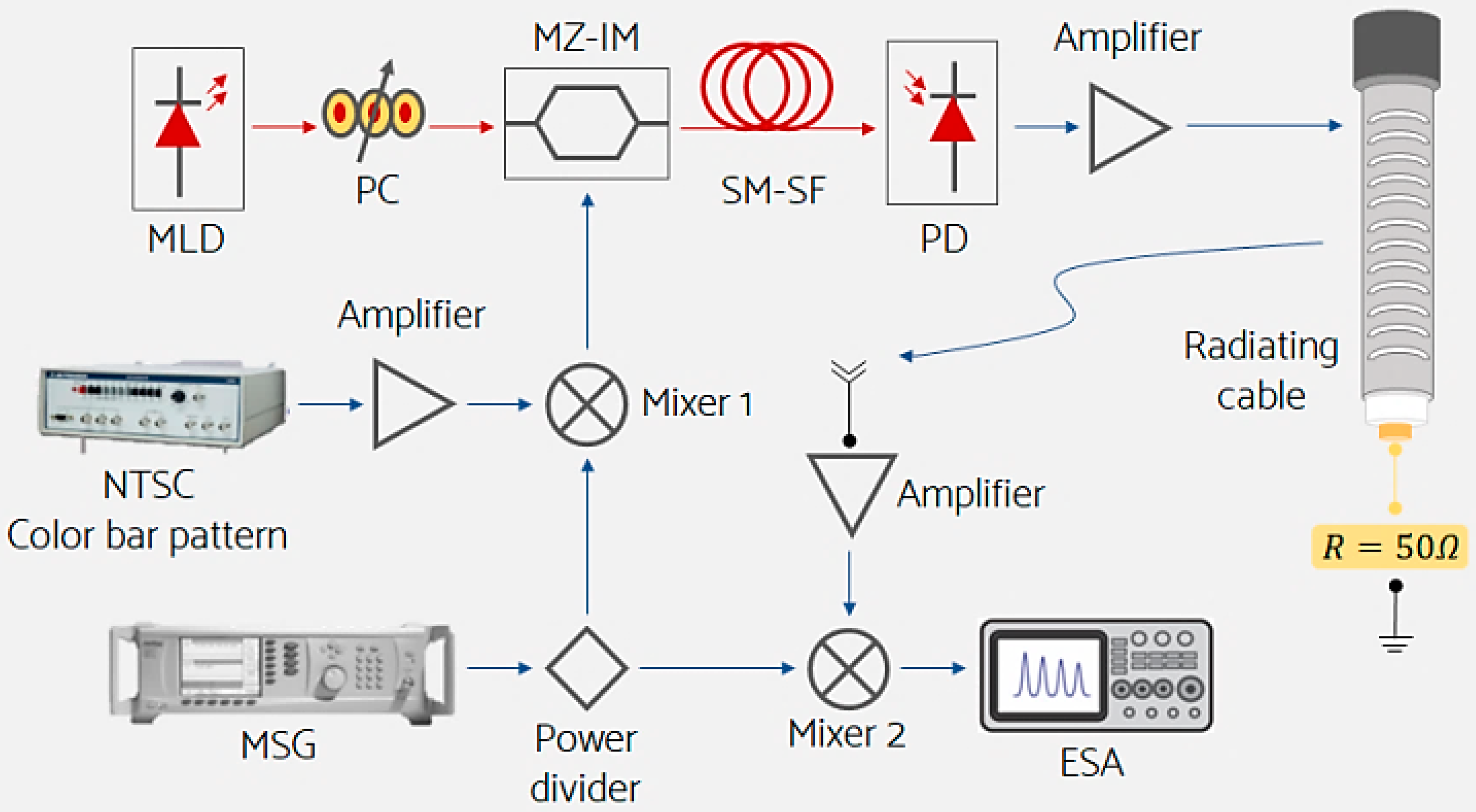Optical Transmission of an Analog TV-Signal Coded at 2.24 GHz and Its Distribution by Using a Radiating Cable
Abstract
:1. Introduction
2. Microwave Photonic Filter
2.1. Principle of Operation
2.2. Experimental MPF Characterization
3. Experimental Results
3.1. Experimental Setup
3.2. Measurement Locations Map
3.3. Results
4. Conclusions
Author Contributions
Funding
Acknowledgments
Conflicts of Interest
References
- Zhang, T.; Feng, J.; Xiao, J.; Tang, J. The Analysis of the Communication Distance in Wireless Optical Communications for Trains. In Proceedings of the 3rd International Conference on Electrical and Information Technologies for Rail Transportation (EITRT) 2017; Springer Science and Business Media: Berlin/Heidelberg, Germany, 2018; Volume 482, pp. 865–870. [Google Scholar]
- Hranilovic, S. Wireless Optical Communication Systems; Springer: Berlin/Heidelberg, Germany, 2005. [Google Scholar]
- Correa Mena, A.G.; Zaldívar Huerta, I.E.; Seseña Osorio, J.; Aragón Zavala, A.; Abril García, J.H.; García Juárez, A. Experimental optical transmission of electrical signals in the frequency range of 0.9–2.3 GHz and its distribution by using a radiating cable. Environments 2016, 2, 3. [Google Scholar]
- Jiang, J.; Wang, L.; Wang, G. Leaky coaxial cable for near-field UHF RFID applications. In Proceedings of the 2017 Sixth Asia-Pacific Conference on Antennas and Propagation (APCAP), Xi’an, China, 16–19 October 2017; pp. 1–3. [Google Scholar]
- Siddiqui, Z.; Sonkki, M.; Tuhkala, M.; Myllymäki, S. Sinusoidally Modulated Reactance Surface Loaded Leaky Coaxial Cable. In Proceedings of the 13th European Conference on Antennas and Propagation (EuCAP), Krakow, Poland, 31 March–5 April 2019; pp. 1–4. [Google Scholar]
- Siddiqui, Z.; Sonkki, M.; Tuhkala, M.; Myllymaki, S. Leaky Coaxial Cable with Enhanced Radiation Performance for Indoor Communication Systems. In Proceedings of the 2019 16th International Symposium on Wireless Communication Systems (ISWCS), Oulu, Finland, 27–30 August 2019; pp. 724–727. [Google Scholar]
- Kamruzzaman, S.M.; Fernando, X.; Jaseemuddin, M.; Farjow, W. Reliable Communication Network for Emergency Response and Disaster Management in Underground Mines. In Handbook of Research on Accounting and Financial Studies; IGI Global: Hershey, PA, USA, 2018; pp. 41–85. [Google Scholar]
- Capmany, J.; Ortega, B.; Pastor, D. A tutorial on microwave photonic filters. J. Light. Technol. 2006, 24, 201–229. [Google Scholar] [CrossRef]
- Capmany, J.; Mora, J.; Gasulla, I.; Sancho, J.; Lloret, J.; Sales, S. Microwave Photonic Signal Processing. J. Light. Technol. 2013, 31, 571–586. [Google Scholar] [CrossRef]
- Chung, H.S.; Chang, S.H.; Park, J.D.; Chu, M.-J.; Kim, K. Transmission of Multiple HD-TV Signals Over a Wired/Wireless Line Millimeter-Wave Link With 60 GHz. J. Light. Technol. 2007, 25, 3413–3418. [Google Scholar] [CrossRef]
- Dudley, S.; Quinlan, T.; Walker, S. Ultrabroadband Wireless–Optical Transmission Links Using Axial Slot Leaky Feeders and Optical Fiber for Underground Transport Topologies. IEEE Trans. Veh. Technol. 2008, 57, 3471–3476. [Google Scholar] [CrossRef]
- Zaldívar-Huerta, I.E.; García-Juárez, A.; Pérez-Montaña, D.; Nava, P.H.; Vera-Marquina, A. Proposal and performance evaluation of a Fiber-To-The-Antenna system for video distribution operating in the S-band. Opt. Laser Technol. 2015, 71, 89–94. [Google Scholar] [CrossRef] [Green Version]
- Icedo-Navarro, J.A.; Rodríguez, R.E.T.; García-Juárez, A.; Noriega-Luna, J.R.; Correa-Mena, A.G.; González-Mondragón, L.A.; Zaldivar-Huerta, I.E. Transmission system for digital TV-signal distribution through a passive optical network in the microwave S-band. In Proceedings of the 2017 IEEE 9th Latin-American Conference on Communications (LATINCOM), Guatemala City, Guatemala, 8–10 November 2017; pp. 1–6. [Google Scholar]
- Habib, U.; Steeg, M.; Stohr, A.; Gomes, N.J. Radio-over-Fiber-supported Millimeter-wave Multiuser Transmission with Low-Complexity Antenna Units. In Proceedings of the 2018 International Topical Meeting on Microwave Photonics (MWP), Toulouse, France, 22–25 October 2018; pp. 1–4. [Google Scholar] [CrossRef] [Green Version]
- Habib, U.; Aighobahi, A.E.; Quinlan, T.; Walker, S.D.; Gomes, N.J. Analog Radio-Over-Fiber Supported Increased RAU Spacing for 60 GHz Distributed MIMO Employing Spatial Diversity and Multiplexing. J. Light. Technol. 2018, 36, 4354–4360. [Google Scholar] [CrossRef]
- González-Mondragón, L.A.; Quintero-Rodríguez, L.J.; García-Juárez, A.; Vera-Marquina, A.; Zaldívar-Huerta, I.E. Multiple passband microwave photonic filter with adjustable bandwidth. Opt. Laser Technol. 2020, 126, 106133. [Google Scholar] [CrossRef]
- SaM Solutions company VPIphotonics: Simulation Software and Design Services. Available online: https://www.vpiphotonics.com/index.php (accessed on 10 March 2020).
- Ovadia, S. Broadband Cable TV Access Networks, 1st ed; Prentice Hall: New Jersey, NJ, USA, 2001. [Google Scholar]
- RCF, R.F.S. PRODUCT DATASHEET RCF12-50JFN. 2018. Available online: http://products.rfsworld.com//WebSearchECat/datasheets/pdf/cache/RCF12-50JFN.pdf (accessed on 18 March 2020).
- Sesena-Osorio, J.A.; Aragón-Zavala, A.; Zaldívar-Huerta, I.E.; Castanon, G. INDOOR PROPAGATION MODELING FOR RADIATING CABLE SYSTEMS IN THE FREQUENCY RANGE OF 900-2500 MHZ. Prog. Electromagn. Res. B 2013, 47, 241–262. [Google Scholar] [CrossRef] [Green Version]
- IEEE Standard for Safety Levels with Respect to Human Exposure to Radio Frequency Electromagnetic Fields, 3 kHz to 300 GHz 2008. Available online: https://standards.ieee.org/standard/C95_1-1991.html (accessed on 19 May 2020).
- Qaddus, A. An Evaluation of 2.4 GHz and 5 GHz ISM Radio Bands Utilization in Backhaul IP Microwave Wireless Networks. In Proceedings of the 2019 International Conference on Information Science and Communications Technologies (ICISCT), Tashkent, Uzbekistan, 4–6 November 2019. [Google Scholar]






| Ref. | Carrier (GHz) | SNRRX (dB) | Fiber Coil (km) | Radiating Cable | Wireless Reception |
|---|---|---|---|---|---|
| 2007 [10] | 60 | 26 | SMF: 20 | ✕ | ✓ |
| 2008 [11] | 4 | - | SMF: 4 | ✓ | ✓ |
| 2015 [12] | 2.27; 4.54 | 38.25; 37.83 | SM-SF: 25.24 | ✕ | ✓ |
| 2016 [3] | 0.9–2.3 | ≈ 39 | SM-SF: 25.24 | ✓ | ✓ |
| 2017 [13] | 2.4 | 38.8 | SM-SF: 30 | ✕ | ✕ |
| 2018 [14] | 60 | - | SMF: 2.2 | ✓ | ✓ |
| 2018 [15] | 60 | - | SMF: 2.2 | ✕ | ✓ |
| This work | 2.24 | 36.53 | SM-SF: 25.28 | ✓ | ✓ |
| Frequency fn | Theoretical fn (GHz) | Experimental fn (GHz) | Theoretical Δfbp (MHz) | Experimental Δfbp (MHz) | % Error | Experimental SNR (dB) |
|---|---|---|---|---|---|---|
| f1 | 2.27 | 2.24 | 362.82 | 350 | 1.32 | 13.27 |
| f2 | 4.55 | 4.40 | 3.29 | 12.79 | ||
| f3 | 6.82 | 6.62 | 2.93 | 12.11 | ||
| f4 | 9.10 | 8.86 | 2.63 | 11.15 |
© 2020 by the authors. Licensee MDPI, Basel, Switzerland. This article is an open access article distributed under the terms and conditions of the Creative Commons Attribution (CC BY) license (http://creativecommons.org/licenses/by/4.0/).
Share and Cite
Correa-Mena, A.G.; Seseña-Osorio, J.A.; Diago-Mosquera, M.E.; Aragón-Zavala, A.; Zaldívar-Huerta, I.E. Optical Transmission of an Analog TV-Signal Coded at 2.24 GHz and Its Distribution by Using a Radiating Cable. Electronics 2020, 9, 917. https://doi.org/10.3390/electronics9060917
Correa-Mena AG, Seseña-Osorio JA, Diago-Mosquera ME, Aragón-Zavala A, Zaldívar-Huerta IE. Optical Transmission of an Analog TV-Signal Coded at 2.24 GHz and Its Distribution by Using a Radiating Cable. Electronics. 2020; 9(6):917. https://doi.org/10.3390/electronics9060917
Chicago/Turabian StyleCorrea-Mena, Ana Gabriela, Jorge Alberto Seseña-Osorio, Melissa Eugenia Diago-Mosquera, Alejandro Aragón-Zavala, and Ignacio Enrique Zaldívar-Huerta. 2020. "Optical Transmission of an Analog TV-Signal Coded at 2.24 GHz and Its Distribution by Using a Radiating Cable" Electronics 9, no. 6: 917. https://doi.org/10.3390/electronics9060917





